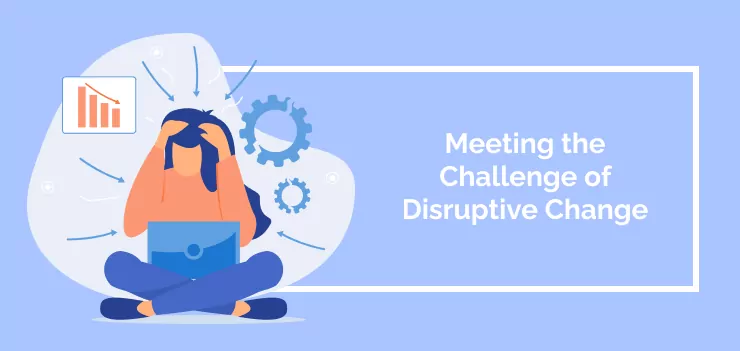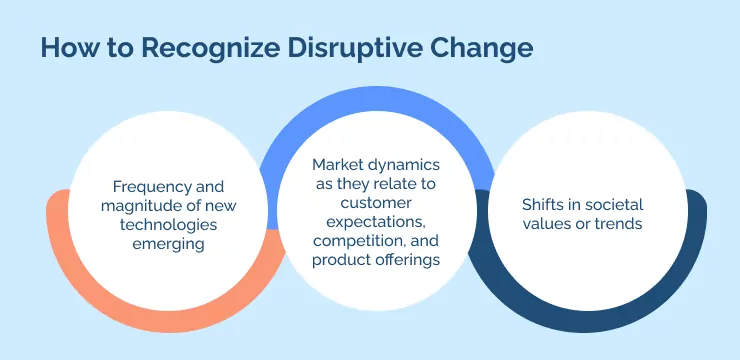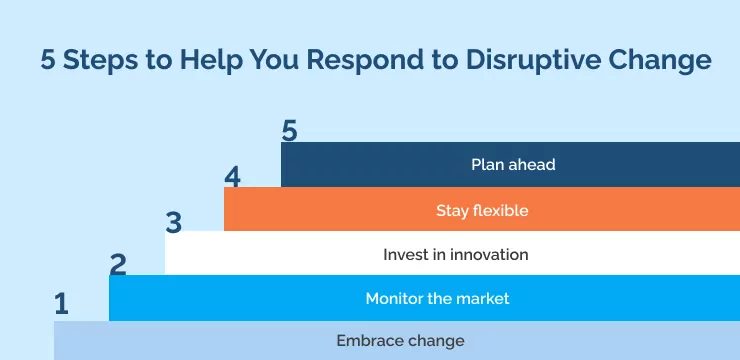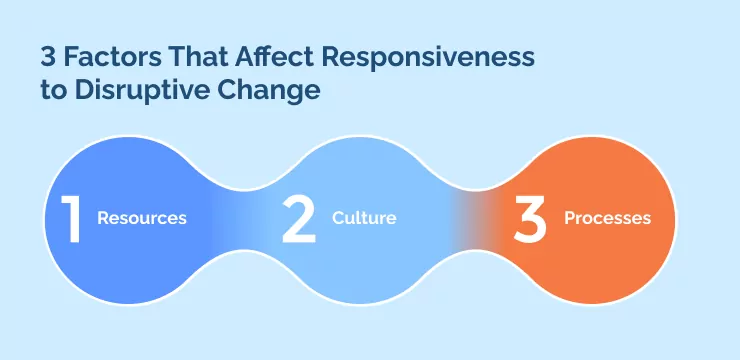
If there’s one thing business leaders have learned from recent years, it’s always to be prepared for disruptive change.
Disruptive change differs from normal change management in that it’s usually unexpected.
Businesses must be prepared for disruption at any moment, whether introducing new technology, adopting a different approach to traditional methods, or creating completely novel products or services.
And it’s not enough just to adapt quickly to whatever comes your way. You also have to proactively seek out opportunities for innovation to stay ahead of the competition in today’s dynamic markets.
We understand the challenge this presents—and we’re here to help.
If you’ve been building your change capabilities, you’ll be well-positioned to handle disruptive changes, but you should make a few additional considerations.
In this article, we’ll explore how CIOs and business leaders can position their organizations on the cutting edge by meeting and overcoming these challenges head-on through creativity, teamwork, and strategic planning.
Understanding Disruptive Change – What It Is & How to Adapt
If you want to be able to deal with disruptive change, you first have to understand what it is and how it works.
Disruptive change refers to a significant shift in the market, societal values, or technology that alters how things are done. It can be so impactful that it transforms entire industries or the world.
Adapting to disruptive change may seem difficult, but with a few changes in mentality and approach, any business can navigate it successfully.
Be open to new ideas and perspectives, be willing to experiment, and be proactive in staying ahead of new changes.
With a positive mindset and willingness to adapt, any business leader can turn disruptive change into an opportunity for growth and success.
Why Does Disruptive Change Management Matter?
The importance of disruptive change management lies in one simple fact:
Disruptive change presents new business opportunities for those bold enough to embrace it.
As markets and technology evolve, new ways to approach products or services exist. By proactively seeking out and exploiting these opportunities, you can stay ahead of your competitors, capture more market share, allow for greater innovation in your business offerings, and open up possibilities that would otherwise be closed off.
In addition, staying on top of disruptive change helps you remain relevant as the world evolves and new technologies emerge. By meeting these challenges head-on, you gain a competitive edge and position yourself and your business for long-term success in the marketplace.
How to Recognize Disruptive Change
There are a few key indicators of disruptive change that business leaders can look out for to stay ahead:
- Frequency and magnitude of new technologies emerging
- Market dynamics as they relate to customer expectations, competition, and product offerings
- Shifts in societal values or trends
By monitoring these areas regularly, you can identify when disruptive change occurs and position your business to respond quickly.
In addition, it can be helpful to look out for specific changes in the market that signal a shift away from traditional methods. Digital platforms, artificial intelligence, automation, and machine learning are technologies and trends that have disrupted industries and changed how we do business.
Finally, be on the lookout for changes in customer behavior—such as an increase in user reviews or a decrease in demand for certain products or services—as this could signal that disruptive change is taking place in the market.
By being aware of these signs and paying attention to their implications, you can stay one step ahead of your competitors and be prepared to take advantage of any new opportunities.
How Does Disruptive Change Affect Business?
When a disruptive change takes place, it can have a huge impact on businesses of all sizes.
Existing products or services often become obsolete as new technologies and customer demands enter the market. Companies must then adapt by introducing new offerings, updating old ones to fit current trends, or even completely transforming their business models.
In addition, disruptive change can shift the competitive landscape as new players enter the field with innovative products and services. Businesses must be prepared to compete with these newcomers or risk being left behind.
Finally, regulation or customer behavior changes can affect how businesses operate. Companies may need to adjust their processes or services to conform to new laws and regulations or address changes in customer preferences.
Overall, disruptive change can be a difficult challenge for businesses to navigate. However, you can find opportunities in the chaos with the right attitude and an agile approach.
5 Steps to Help You Respond to Disruptive Change
We’ve covered everything you need to know about the nature of disruptive change, so now we will share practical steps you can take to help make your business more resilient to disruption.
We’ve distilled the best advice into just five steps:
- Embrace change
- Monitor the market
- Invest in innovation
- Stay flexible
- Plan ahead
Let’s take a more detailed look at each of these steps.
Embrace Change
You must be willing to accept and adapt to changes in the market if you want to stay competitive. Acknowledge that disruptive change is inevitable, even desirable, and look for ways to capitalize on new opportunities.
Monitor the Market
Keep an eye out for indicators of disruptive change, such as emerging technologies or customer behavior shifts, so you can quickly respond when necessary.
Invest in Innovation
Investing in innovation can help your business stay ahead of the competition and find new sources of revenue from disruptive changes occurring in the market.
Keep Your Business Model Flexible
The key to successfully navigating disruptive change is maintaining a flexible attitude and approach to business operations. Be prepared to pivot quickly and adjust your processes or services when necessary.
Plan Ahead
A plan for responding to disruptive change can help you stay one step ahead of the competition. Consider how you want to react if certain changes happen in the market, and create strategies to keep your team agile and competitive.
By taking these steps, you can proactively respond to disruptive change and ensure your business is well-positioned to take advantage of the opportunities. With a little preparation, you can turn disruption into an opportunity for success.
3 Factors That Affect Responsiveness to Disruptive Change
While the above steps will help you deal with disruptive change, you must also be aware of these three factors.
Each one will directly impact your ability to adapt to disruptive change.
1. Resources
The resources that you have at your disposal.
This includes technology, equipment, human resource, cash, etc.
The more resources you have, the more you can allocate to dealing with disruptive change. Ideally, you’ll always have the wiggle room to spin up a new business function if necessary.
2. Culture
Employees inherently resist change, and it’s difficult for a business to pivot in response to disruptive change if its employees fight every step.
The more change-friendly a culture you can cultivate within your ranks, the less impactful disruptive changes will be.
The keys to encouraging a change-friendly are collaboration and openness. Keeping your employees in the loop goes a long way toward fostering a sense of camaraderie.
3. Processes
The more complex your existing processes, the harder it will be to maneuver them around disruptive changes thrown your way.
You should proactively streamline and automate processes wherever possible so that it’s easiest to lift and shift them in response to disruption.
Turn Disruptive Change into Disruptive Innovation
Change is unnerving at the best of times and downright scary at the worst.
But it is an inevitable fixture of the business landscape. You cannot avoid it, and there’s no good denying it.
Change is coming, disrupting everything you thought was stable about your business. But once you accept that, you can move on to recognizing it and dealing with it.
With a little mindset adjustment, you can maximize the roiling chaos of disruptive change. You can leapfrog the competition and storm ahead while your competitors are left reeling.
WalkMe Team
WalkMe spearheaded the Digital Adoption Platform (DAP) for associations to use the maximum capacity of their advanced resources. Utilizing man-made consciousness, AI, and context-oriented direction, WalkMe adds a powerful UI layer to raise the computerized proficiency, everything being equal.






